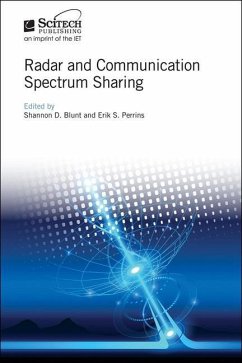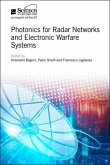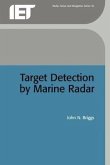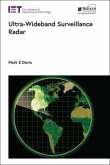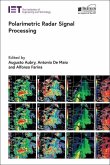Radar and Communication Spectrum Sharing
Herausgeber: Blunt, Shannon D.; Perrins, Erik S.
Radar and Communication Spectrum Sharing
Herausgeber: Blunt, Shannon D.; Perrins, Erik S.
- Gebundenes Buch
- Merkliste
- Auf die Merkliste
- Bewerten Bewerten
- Teilen
- Produkt teilen
- Produkterinnerung
- Produkterinnerung
This book addresses the growing conflict over use of the radio-frequency spectrum by different systems, such as civil and security applications of radar and consumer use for wireless communications. The increasing demand for this finite resource is driving innovation into new ways in which these diverse systems can cohabit the spectrum.
Andere Kunden interessierten sich auch für
![The Impact of Cognition on Radar Technology The Impact of Cognition on Radar Technology]() The Impact of Cognition on Radar Technology181,99 €
The Impact of Cognition on Radar Technology181,99 €![Deep Neural Network Design for Radar Applications Deep Neural Network Design for Radar Applications]() Deep Neural Network Design for Radar Applications156,99 €
Deep Neural Network Design for Radar Applications156,99 €![Photonics for Radar Networks and Electronic Warfare Systems Photonics for Radar Networks and Electronic Warfare Systems]() Photonics for Radar Networks and Electronic Warfare Systems153,99 €
Photonics for Radar Networks and Electronic Warfare Systems153,99 €![Radar Waveform Design Based on Optimization Theory Radar Waveform Design Based on Optimization Theory]() Radar Waveform Design Based on Optimization Theory165,99 €
Radar Waveform Design Based on Optimization Theory165,99 €![Target Detection by Marine Radar Target Detection by Marine Radar]() John N. BriggsTarget Detection by Marine Radar186,99 €
John N. BriggsTarget Detection by Marine Radar186,99 €![Ultra-Wideband Surveillance Radar Ultra-Wideband Surveillance Radar]() Mark E. DavisUltra-Wideband Surveillance Radar161,99 €
Mark E. DavisUltra-Wideband Surveillance Radar161,99 €![Polarimetric Radar Signal Processing Polarimetric Radar Signal Processing]() Polarimetric Radar Signal Processing166,99 €
Polarimetric Radar Signal Processing166,99 €-
-
-
This book addresses the growing conflict over use of the radio-frequency spectrum by different systems, such as civil and security applications of radar and consumer use for wireless communications. The increasing demand for this finite resource is driving innovation into new ways in which these diverse systems can cohabit the spectrum.
Hinweis: Dieser Artikel kann nur an eine deutsche Lieferadresse ausgeliefert werden.
Hinweis: Dieser Artikel kann nur an eine deutsche Lieferadresse ausgeliefert werden.
Produktdetails
- Produktdetails
- Radar, Sonar and Navigation
- Verlag: Institution of Engineering & Technology
- Seitenzahl: 864
- Erscheinungstermin: 27. Dezember 2018
- Englisch
- Abmessung: 236mm x 163mm x 51mm
- Gewicht: 1406g
- ISBN-13: 9781785613579
- ISBN-10: 178561357X
- Artikelnr.: 52416114
- Herstellerkennzeichnung
- Libri GmbH
- Europaallee 1
- 36244 Bad Hersfeld
- 06621 890
- Radar, Sonar and Navigation
- Verlag: Institution of Engineering & Technology
- Seitenzahl: 864
- Erscheinungstermin: 27. Dezember 2018
- Englisch
- Abmessung: 236mm x 163mm x 51mm
- Gewicht: 1406g
- ISBN-13: 9781785613579
- ISBN-10: 178561357X
- Artikelnr.: 52416114
- Herstellerkennzeichnung
- Libri GmbH
- Europaallee 1
- 36244 Bad Hersfeld
- 06621 890
1. Part I: The big picture
* Chapter 1: The case for spectrum access
* Chapter 2: The spectrum crunch - a radar perspective
* Chapter 3: Spectrum sharing between radar and small cells
* Chapter 4: Radar spectrum sharing: history, lessons learned, and ways
forward
* Chapter 5: Spectrum use, congestion, issues, and research areas at
radio-frequencies
2. Part II: Systems engineering perspectives
* Chapter 6: Spectrally efficient communications and radar
* Chapter 7: Passive bistatic radar for spectrum sharing
* Chapter 8: Symbiosis for communications, broadcasting and sensor
systems in the white space TV band
* Chapter 9: Fusion of radar sensing, data communications, and GPS
interoperability via software-defined OFDM architecture
* Chapter 10: Adaptive RF multi-interference suppression for wideband
radar/communication receivers
* Chapter 11: Transmitter architectures for radar/communication
spectral coexistence
* Chapter 12: Adaptively reconfigurable radar: real-time optimization
of the transmitter amplifier and waveforms
3. Part III: Addressing interference
* Chapter 13: Radar/Wi-Fi spectrum sharing: evaluation of radar
protection regions
* Chapter 14: Spectrum sharing via interference tolerant transform
domain waveform design
* Chapter 15: Radar bandwidth optimization for interference mitigation
* Chapter 16: Compressed sensing and interference occupancy monitoring
for spectrum sharing in spectrally dense environments
* Chapter 17: Radar waveform design for spectral coexistence
* Chapter 18: Space-time transmit nulling for RF spectrum
interoperability
4. Part IV: Radar/communication co-design
* Chapter 19: Communication and radar co-design
* Chapter 20: Real-time radar/communication spectrum sharing based on
information exchange
* Chapter 21: Embedding communication symbols in radar clutter on an
intrapulse basis
* Chapter 22: Dual-function radar - communications using sidelobe
control
* Chapter 23: Embedding communications into radar emissions by transmit
waveform diversity
* Chapter 1: The case for spectrum access
* Chapter 2: The spectrum crunch - a radar perspective
* Chapter 3: Spectrum sharing between radar and small cells
* Chapter 4: Radar spectrum sharing: history, lessons learned, and ways
forward
* Chapter 5: Spectrum use, congestion, issues, and research areas at
radio-frequencies
2. Part II: Systems engineering perspectives
* Chapter 6: Spectrally efficient communications and radar
* Chapter 7: Passive bistatic radar for spectrum sharing
* Chapter 8: Symbiosis for communications, broadcasting and sensor
systems in the white space TV band
* Chapter 9: Fusion of radar sensing, data communications, and GPS
interoperability via software-defined OFDM architecture
* Chapter 10: Adaptive RF multi-interference suppression for wideband
radar/communication receivers
* Chapter 11: Transmitter architectures for radar/communication
spectral coexistence
* Chapter 12: Adaptively reconfigurable radar: real-time optimization
of the transmitter amplifier and waveforms
3. Part III: Addressing interference
* Chapter 13: Radar/Wi-Fi spectrum sharing: evaluation of radar
protection regions
* Chapter 14: Spectrum sharing via interference tolerant transform
domain waveform design
* Chapter 15: Radar bandwidth optimization for interference mitigation
* Chapter 16: Compressed sensing and interference occupancy monitoring
for spectrum sharing in spectrally dense environments
* Chapter 17: Radar waveform design for spectral coexistence
* Chapter 18: Space-time transmit nulling for RF spectrum
interoperability
4. Part IV: Radar/communication co-design
* Chapter 19: Communication and radar co-design
* Chapter 20: Real-time radar/communication spectrum sharing based on
information exchange
* Chapter 21: Embedding communication symbols in radar clutter on an
intrapulse basis
* Chapter 22: Dual-function radar - communications using sidelobe
control
* Chapter 23: Embedding communications into radar emissions by transmit
waveform diversity
1. Part I: The big picture
* Chapter 1: The case for spectrum access
* Chapter 2: The spectrum crunch - a radar perspective
* Chapter 3: Spectrum sharing between radar and small cells
* Chapter 4: Radar spectrum sharing: history, lessons learned, and ways
forward
* Chapter 5: Spectrum use, congestion, issues, and research areas at
radio-frequencies
2. Part II: Systems engineering perspectives
* Chapter 6: Spectrally efficient communications and radar
* Chapter 7: Passive bistatic radar for spectrum sharing
* Chapter 8: Symbiosis for communications, broadcasting and sensor
systems in the white space TV band
* Chapter 9: Fusion of radar sensing, data communications, and GPS
interoperability via software-defined OFDM architecture
* Chapter 10: Adaptive RF multi-interference suppression for wideband
radar/communication receivers
* Chapter 11: Transmitter architectures for radar/communication
spectral coexistence
* Chapter 12: Adaptively reconfigurable radar: real-time optimization
of the transmitter amplifier and waveforms
3. Part III: Addressing interference
* Chapter 13: Radar/Wi-Fi spectrum sharing: evaluation of radar
protection regions
* Chapter 14: Spectrum sharing via interference tolerant transform
domain waveform design
* Chapter 15: Radar bandwidth optimization for interference mitigation
* Chapter 16: Compressed sensing and interference occupancy monitoring
for spectrum sharing in spectrally dense environments
* Chapter 17: Radar waveform design for spectral coexistence
* Chapter 18: Space-time transmit nulling for RF spectrum
interoperability
4. Part IV: Radar/communication co-design
* Chapter 19: Communication and radar co-design
* Chapter 20: Real-time radar/communication spectrum sharing based on
information exchange
* Chapter 21: Embedding communication symbols in radar clutter on an
intrapulse basis
* Chapter 22: Dual-function radar - communications using sidelobe
control
* Chapter 23: Embedding communications into radar emissions by transmit
waveform diversity
* Chapter 1: The case for spectrum access
* Chapter 2: The spectrum crunch - a radar perspective
* Chapter 3: Spectrum sharing between radar and small cells
* Chapter 4: Radar spectrum sharing: history, lessons learned, and ways
forward
* Chapter 5: Spectrum use, congestion, issues, and research areas at
radio-frequencies
2. Part II: Systems engineering perspectives
* Chapter 6: Spectrally efficient communications and radar
* Chapter 7: Passive bistatic radar for spectrum sharing
* Chapter 8: Symbiosis for communications, broadcasting and sensor
systems in the white space TV band
* Chapter 9: Fusion of radar sensing, data communications, and GPS
interoperability via software-defined OFDM architecture
* Chapter 10: Adaptive RF multi-interference suppression for wideband
radar/communication receivers
* Chapter 11: Transmitter architectures for radar/communication
spectral coexistence
* Chapter 12: Adaptively reconfigurable radar: real-time optimization
of the transmitter amplifier and waveforms
3. Part III: Addressing interference
* Chapter 13: Radar/Wi-Fi spectrum sharing: evaluation of radar
protection regions
* Chapter 14: Spectrum sharing via interference tolerant transform
domain waveform design
* Chapter 15: Radar bandwidth optimization for interference mitigation
* Chapter 16: Compressed sensing and interference occupancy monitoring
for spectrum sharing in spectrally dense environments
* Chapter 17: Radar waveform design for spectral coexistence
* Chapter 18: Space-time transmit nulling for RF spectrum
interoperability
4. Part IV: Radar/communication co-design
* Chapter 19: Communication and radar co-design
* Chapter 20: Real-time radar/communication spectrum sharing based on
information exchange
* Chapter 21: Embedding communication symbols in radar clutter on an
intrapulse basis
* Chapter 22: Dual-function radar - communications using sidelobe
control
* Chapter 23: Embedding communications into radar emissions by transmit
waveform diversity

